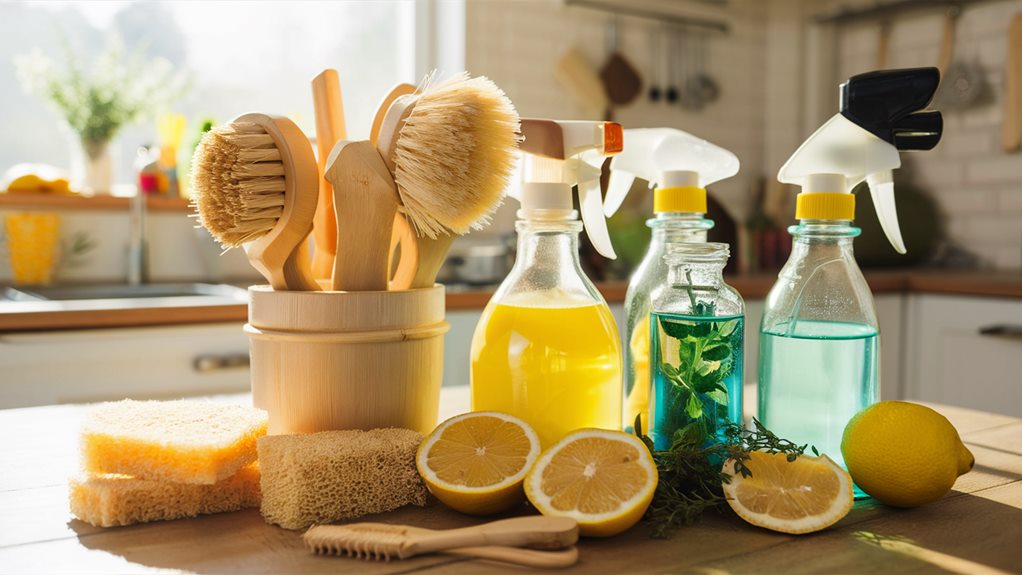To create a healthier home environment, you should switch to natural cleaning agents like vinegar and baking soda, which are effective and environmentally friendly. Additionally, adopting green cleaning tools made from materials such as bamboo or recycled plastics boosts sustainability. You can also make your own cleaning solutions to minimize the use of harsh chemicals and prioritize indoor air quality by choosing products that don't release volatile organic compounds (VOCs). Finally, engage in sustainable waste management by composting and recycling, which reduces landfill waste and helps conserve natural resources. Each of these steps not only contributes to a cleaner home but also to a more sustainable world, inviting you to explore further into sustainable habits.
Key Takeaways
- Use natural cleaning agents like vinegar and baking soda to reduce chemical exposure.
- Choose cleaning tools made from sustainable materials such as bamboo or recycled plastics.
- Create homemade cleaning solutions with ingredients like lemon and essential oils for effective, non-toxic cleaning.
- Enhance indoor air quality by incorporating air purifying plants like spider plants and peace lilies.
- Implement sustainable waste management by composting and recycling to minimize environmental impact.
Opt for Natural Cleaning Agents
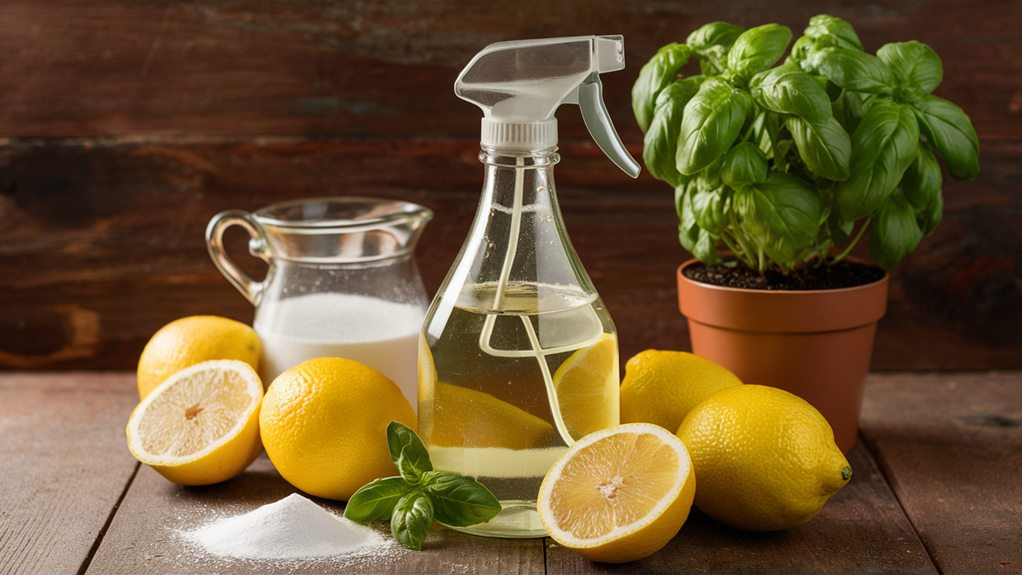
Many households are now turning to natural cleaning agents as a safer, more environmentally friendly option. You're likely aware of the growing concerns regarding the chemicals in traditional cleaners and their impact on health and the environment. By choosing natural alternatives, you're not only protecting your family but also contributing to a broader community effort to promote sustainable living. For instance, using products like eco-friendly dish soaps can further enhance your commitment to a greener household.
Among the most effective and versatile natural cleaners are vinegar and baking soda. When used together, they create a powerful reaction that can tackle grime, unclog drains, and neutralize odors, making them ideal for a variety of cleaning tasks.
Vinegar, an acidic solution, is excellent for dissolving mineral deposits and grease. Meanwhile, baking soda, a mild alkali, is effective in removing stains and brightening surfaces.
To enhance the cleaning power and add a pleasant aroma, consider integrating essential oils into your regimen. Essential oils such as lemon, tea tree, and lavender not only leave your home smelling fresh but also possess natural antibacterial properties.
For instance, adding a few drops of tea tree oil to a vinegar and water solution can create an all-purpose cleaner that's effective against most household bacteria.
Adopt Green Cleaning Tools
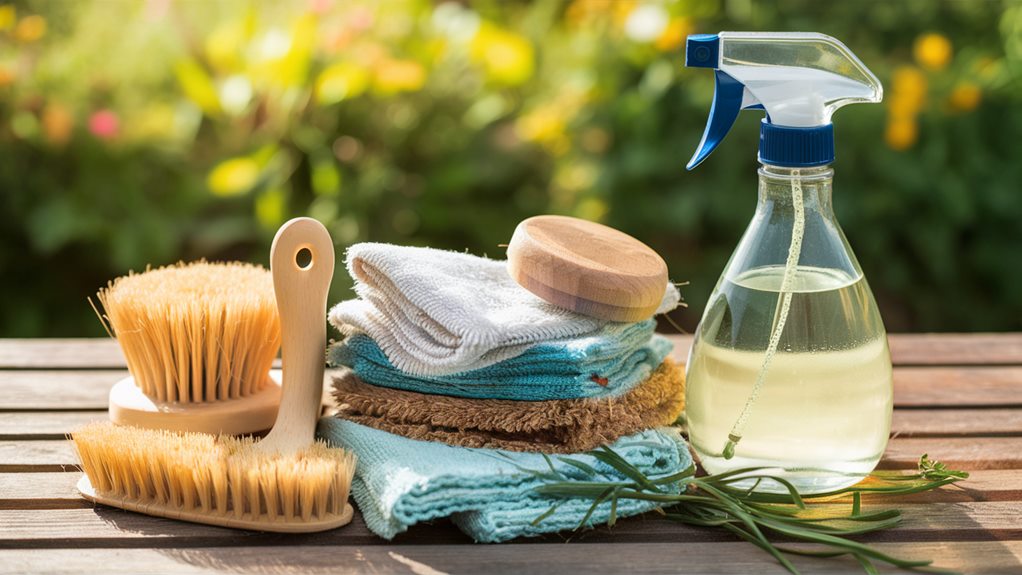
Switching to green cleaning tools complements your use of natural cleaning agents, enhancing your home's sustainability. By adopting tools made from eco-friendly products, you're not just cleaning your space—you're part of a larger community committed to environmental responsibility. Additionally, consider using tools designed for specific tasks, such as paint roller kits that incorporate durable and sustainable materials, which can further reduce your environmental footprint.
Consider the materials of your cleaning tools. Traditional sponges and scrubbers are often made from synthetic materials that aren't biodegradable. Instead, opt for items made with natural fibers like bamboo, coconut husks, or recycled plastics. These non-toxic alternatives aren't only better for the planet but also safe for your family's health.
Next, evaluate the durability and lifecycle of the products you choose. Eco-friendly tools like wooden dish brushes with replaceable heads or microfiber cloths that can be washed and reused reduce waste significantly. This shift not only lessens the load in landfills but also decreases your need to purchase replacements frequently.
You should also consider the end-of-life options for these tools. Many green cleaning products are designed with compostability in mind, allowing you to dispose of them without contributing to pollution. This thoughtful disposal is an integral part of maintaining an eco-conscious home.
Lastly, remember that every small change contributes to a bigger impact. By selecting tools that align with these sustainable practices, you're not only ensuring a cleaner home but are also supporting industries that prioritize the environment. This solidarity in choices fosters a sense of belonging among like-minded individuals who are all working towards a healthier planet.
DIY Eco-Friendly Solutions

Creating your own eco-friendly cleaning solutions can significantly reduce your dependence on chemically-intensive products and lessen your environmental impact. By crafting homemade recipes, you're not only making eco-friendly alternatives but also customizing products to meet your home's specific needs. Additionally, integrating biodegradable sponges into your cleaning routine can further boost your efforts to maintain a sustainable household. Let's explore how you can start.
Firstly, the ingredients for these solutions are likely already in your pantry. Items like vinegar, baking soda, and lemon aren't only cost-effective but also highly efficient in various cleaning tasks. Using these natural components guarantees that you're not introducing harmful chemicals into your home, which aligns with your aim to create a healthier living space.
Consider these five homemade recipes to address different areas of your home:
- All-Purpose Cleaner: Combine equal parts water and vinegar in a spray bottle, adding a few drops of lemon essential oil for a pleasant scent.
- Glass Cleaner: Mix 1/4 cup vinegar, 1/4 cup rubbing alcohol, 1 tablespoon cornstarch, and 2 cups of water. Shake well before each use.
- Scouring Paste: Create a paste with equal parts baking soda and water, apply to surfaces, let it sit, then scrub and rinse.
- Carpet Stain Remover: Dissolve 1/4 cup salt in 1/4 cup borax and 1/4 cup vinegar to form a paste, apply to the stain, let it dry, then vacuum.
- Wood Polish: Blend 1/2 cup olive oil with 1/4 cup white vinegar and a few drops of your preferred essential oil.
Prioritize Indoor Air Quality
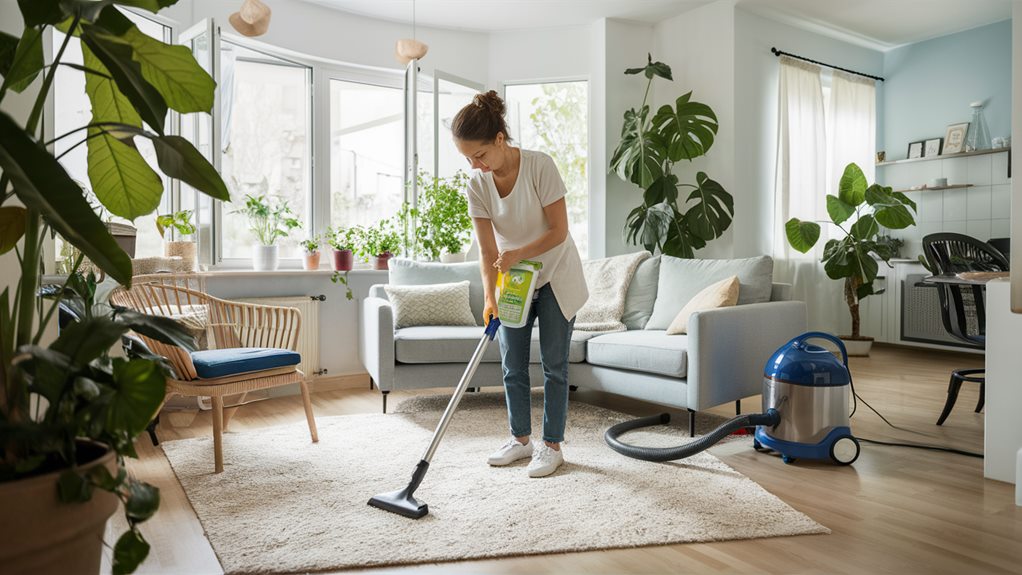
To prioritize indoor air quality, it's pivotal to think about the products you use for cleaning. Many household cleaners contain volatile organic compounds (VOCs) that can notably degrade indoor air quality. Instead, you might opt for natural, homemade solutions like vinegar or baking soda. These alternatives effectively clean without releasing harmful chemicals into your home, ensuring you're not compromising the air you breathe.
Beyond choosing safer cleaning products, integrating air purifying plants into your living spaces can make a noteworthy difference. Plants such as spider plants, peace lilies, and Boston ferns not only add a touch of greenery and a sense of belonging but also naturally filter toxins from the air. They absorb pollutants like formaldehyde and benzene, commonly found in some household products, and convert them into harmless substances.
Another effective strategy is using non-toxic paint for your walls. Traditional paints often emit VOCs long after application, subtly polluting your home's air. Opting for non-toxic paint reduces these emissions, safeguarding your family's health. These paints are especially vital in rooms where you spend a lot of time, such as bedrooms and living rooms.
Sustainable Waste Management Practices
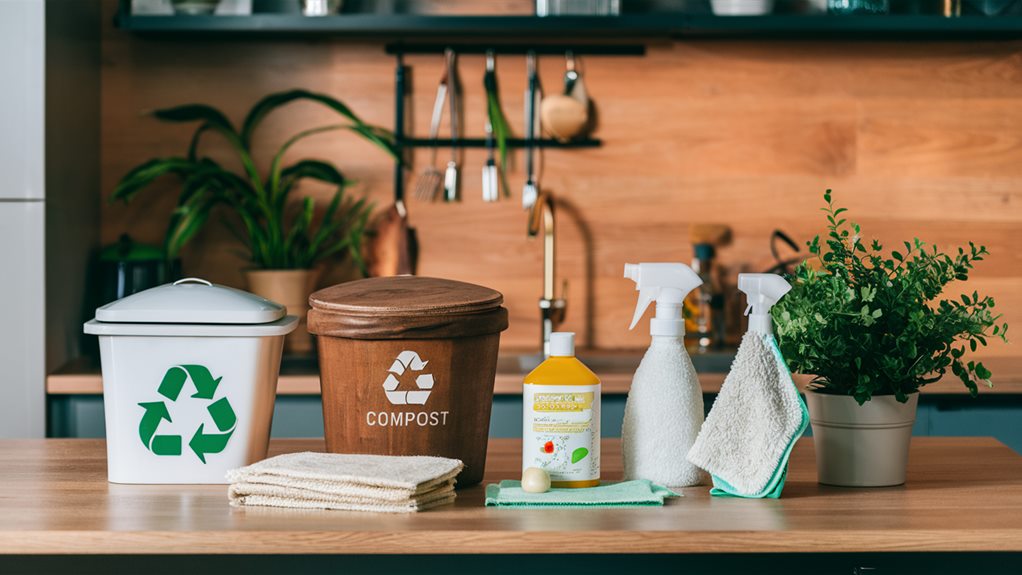
Adopting sustainable waste management practices greatly reduces your environmental footprint and promotes a healthier planet. By taking responsibility for the waste you produce, you're not only cleaning your home but also contributing to the well-being of your community and the earth. Here's how you can effectively manage waste in your home:
- Composting Food Waste: Begin by setting up a compost bin for organic materials. Composting food scraps and other biodegradable items returns nutrients to the soil and reduces greenhouse gas emissions from landfills.
- Recycling Packaging: Always sort your recyclable packaging. Materials like cardboard, plastic, glass, and metal can often be recycled, reducing the demand for raw materials and conserving energy.
- Buying in Bulk: Reduce packaging waste by purchasing food and cleaning supplies in bulk. This action not only minimizes waste but also often saves you money.
- Using Reusable Containers: Swap out single-use plastics for reusable options. Containers made from glass or stainless steel can last for years and cut down on the amount of waste you generate.
- Educating Yourself and Others: Stay informed about your local waste management rules and share this knowledge with friends and family. Understanding what can be recycled and how helps maximize the effectiveness of your efforts.
These steps, while seemingly simple, have profound impacts on the health of our planet. By integrating these practices into your daily routine, you're not only fostering a cleaner home but also joining a community committed to sustainability. Remember, every small action counts in our collective journey towards a more sustainable world.
Frequently Asked Questions
How Do Eco-Friendly Products Impact Long-Term Household Expenses?
When you switch to eco-friendly products, you're looking at notable budget benefits. Initially, these products might seem pricier, but the long-term cost comparison tells a different story. They're often more concentrated and effective, meaning you use less per cleaning session. Over time, this reduces your expenses significantly.
Plus, investing in sustainable solutions can also mean fewer health costs due to fewer chemical exposures, aligning with a community that values health and sustainability.
Can Natural Cleaners Effectively Sanitize and Disinfect?
You might wonder if natural cleaners can really sanitize and disinfect your home. Yes, they can! Natural cleaners are effective when used properly. For instance, vinegar and tea tree oil have proven antibacterial properties. However, their effectiveness can depend on the type of surface and the specific germs you're targeting.
Eco-friendly disinfectants are safe and can provide a healthy alternative without the harsh chemicals found in traditional products, making your space safer and cleaner.
Are There Eco-Friendly Options for Pest Control?
Absolutely, you can tackle pests without harming the planet. Natural repellents, like essential oils and vinegar, keep bugs at bay without toxic chemicals. DIY traps are another effective method; for instance, a simple mix of sugar, water, and yeast can lure and trap mosquitoes. These eco-friendly solutions not only protect your home but also foster a sense of community as you share these safe, creative techniques with friends and family.
How Can I Reduce Cleaning Time Using Green Methods?
To reduce cleaning time using green methods, focus on quick cleaning hacks and green cleaning shortcuts.
You can create effective, eco-friendly cleaning solutions at home using ingredients like vinegar, baking soda, and lemon. These natural products work quickly to break down dirt and grime.
Also, streamline your tasks by cleaning more frequently with these solutions, which prevents build-up and reduces the overall time you spend cleaning. This approach not only saves time but also protects your health and the environment.
What Are the Risks of Mixing Different Eco-Cleaners?
Mixing different eco-cleaners can be risky due to potential chemical reactions. You might assume they're safer than traditional products, but even natural ingredients can interact dangerously.
For example, mixing vinegar with hydrogen peroxide creates peracetic acid, which can be harmful. Always research and follow guidelines to avoid creating health hazards.
Conclusion
To sum up, by embracing natural cleansers and sustainable tools, you're not just enhancing your living space, you're protecting your health and the planet. Creating your own eco-friendly solutions and improving air quality represent proactive steps towards a gentle indoor environment. Lastly, embracing advanced waste management techniques guarantees that your environmental impact is as minimal as can be. Together, these practices contribute to a cleaner, more sustainable living space, exemplifying responsible care of our shared environment.

